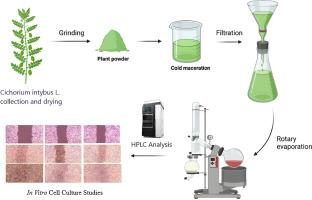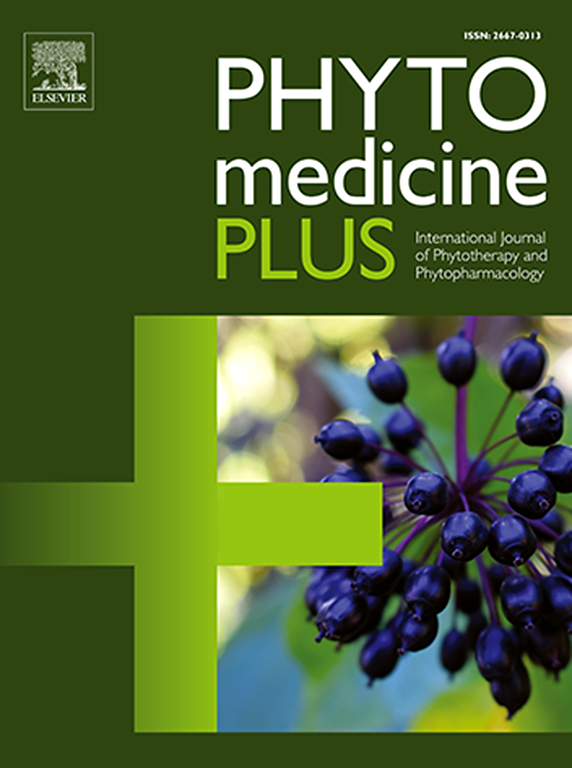评估 Cichorium intybus L. 提取物对伤口的愈合作用
Q3 Pharmacology, Toxicology and Pharmaceutics
引用次数: 0
摘要
背景在人的一生中,可能会遇到各种或轻或重的事件,这些事件有可能导致身体的任何部位出现疤痕。这些疤痕也可能是身体对不同刺激的天生反应。治疗疤痕的药物和方法多种多样。草药疗法一直以来都很受欢迎。本研究的主要目的和新颖之处在于调查从菊苣(Cichorium intybus L.)不同成分(包括根、茎、花和全草)中提取的提取物所固有的潜在治疗属性。这项研究将通过体外划痕试验和体外细胞迁移试验来完成。此外,还对火化灰烬进行了调查,火化灰烬是普通人经常使用的一种方法。研究设计本次调查的重点是评估这些提取物的伤口愈合效果。研究包括对植物的几种成分进行全面检查,以确定表现出最高功效的萃取物。研究分别采用了以下方法来研究植物的伤口愈合能力:收集和鉴定植物、制备萃取物、通过 HPLC-PDA 测定酚类化合物、体外细胞培养研究、细胞活力分析、伤口愈合分析、统计分析。结果研究结果表明,除正己烷萃取物(样品 1)外,C. intybus 的茎萃取物具有显著的伤口愈合特性。色谱结果显示,提取物的主要成分是绿原酸。上述发现为这一特定领域未来研究的潜在方向做出了重要贡献。需要进一步研究其伤口愈合特性的活性化学成分和机制,这有可能促进伤口愈合疗法的发展。本文章由计算机程序翻译,如有差异,请以英文原文为准。

Assessment of the healing properties of Cichorium intybus L. extracts on wounds
Background
Throughout the course of an individual's lifespan, they may come across a diverse range of minor or significant incidents that have the potential to result in the development of scars on any region of their physique. These scars may also be a consequence of the body's innate responses to different stimuli. Various medicinal drugs and methods have been used to treat scars. Herbal remedies have long been popular. Cichorium intybus L., or chicory, has been used for centuries to treat numerous illnesses and deformities.
Purpose
The primary objective and novelty of this research endeavor involve the investigation of potential therapeutic attributes inherent in extracts derived from different components of C. intybus (common chicory), encompassing the root, stem, flower, and whole herba. This will be accomplished through the utilization of in vitro scratch tests and in vitro cell migration assays. Additionally, the ash acquired from cremation, a method routinely employed by the general population, was also investigated.
Study design
The focus of this investigation was to evaluate the wound healing effects of these extracts. The research encompassed a comprehensive examination of several components of the plant in order to ascertain the extracts that exhibited the highest efficacy.
Methods
The study utilized the following approaches respectively to investigate the plant's wound healing abilities: collection and identification of plants, preparation of extracts, determination of phenolic compounds by HPLC-PDA, in vitro cell culture studies, cell viability analysis, wound healing analysis, statistical analysis.
Results
The findings indicated that the stem extracts of C. intybus, with the exception of the hexane extract (Sample 1), demonstrated notable wound healing properties. According to the chromatography results the main component of extract is chlorogenic acid. The aforementioned findings offer significant contributions to the potential directions for future research within this particular sector.
Conclusion
The evidence suggests that extracts from C. intybus have wound healing properties, highlighting its significance in traditional medicine and pharmaceutical research. Further investigation into active chemicals and mechanisms contributing to its wound healing properties is needed, potentially leading to advancements in wound healing therapies.
求助全文
通过发布文献求助,成功后即可免费获取论文全文。
去求助
来源期刊

Phytomedicine Plus
Medicine-Complementary and Alternative Medicine
CiteScore
3.70
自引率
0.00%
发文量
178
审稿时长
81 days
期刊介绍:
 求助内容:
求助内容: 应助结果提醒方式:
应助结果提醒方式:


